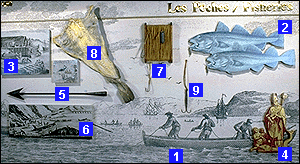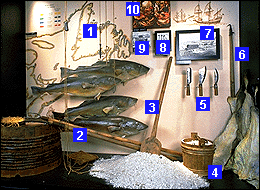Canada Hall
 Shipboard Life
Shipboard Life
Fishing
As Roman Catholics, medieval Europeans venerated the fish as a Christian symbol. Fish was also appreciated by them during the many meatless fast days. In certain dioceses, there were as many as 166 fast days on which meat was not to be eaten.
French, Portuguese and Basque fishermen were the first to fish for cod along the North American coast. From 1500, they fished and dried cod on the south and east coasts of Newfoundland and along the Strait of Belle Isle. Later, Bretons and Normans undertook the exploitation of the banks, from which they brought back salted cod. About 1540, Spanish and French Basques established seasonal whaling stations on the Labrador coast. The English, although few in numbers in Newfoundland before 1570, controlled large areas of the eastern coast of the Avalon Peninsula by 1600.
In the "green fishery", green (fresh) cod was brought back to Europe within a few weeks in a salt brine to be sold as a "fresh" product in the Atlantic ports. A fishing vessel had to be capable of remaining at sea for no less than five months. While it wandered freely along the banks of Newfoundland, the crew fished and prepared their catch on deck, returning home once the hold was filled.
Handlines, used for cod fishing along the banks near the coast of Newfoundland and Acadia, and in the estuary of the river and gulf of the St. Lawrence, have not changed since the sixteenth century. They were usually 46-55 metres long, but varied according to the depth being fished. Those for fishing on the high seas measured 137-165 metres. A lead sinker 12-15 centimetres long and weighing about 700 grams was attached to the end of the line. Two leaders were also tied on the end, each one tipped with a fishhook. Fishermen normally fished two handlines at a time. When not used, the lines were wound on rectangular wooden reels.
 |
|
The "dry fishery" was a response to Europe's year-round demand for fish. Seasonal fishing stations were set up on the shores of Newfoundland, Labrador and Acadia for the taking and drying of cod. Fishermen spent the summer there, going out to sea in dories. Their catch was processed on shore. Great quantities of cod were preserved and stored in this way for transport to European markets at summer's end.
Dried cod was a preferred food in Portugal, in Mediterranean regions such as Provence, Spain, Italy and the Levant, as well as in the interior of continental Europe. Because it was not prone to spoilage during prolonged transport without refrigeration, it generally reached the consumer in good condition and still could be preserved for more than three years.
Up to four hundred ships and thousands of men worked every summer in the dry fishery. Fishermen in small boats hauled up cod on handlines. At shore stations, crews salted the cod and laid it out to dry on the beach or on platforms. The fish were then stacked to continue drying.
 |
|
